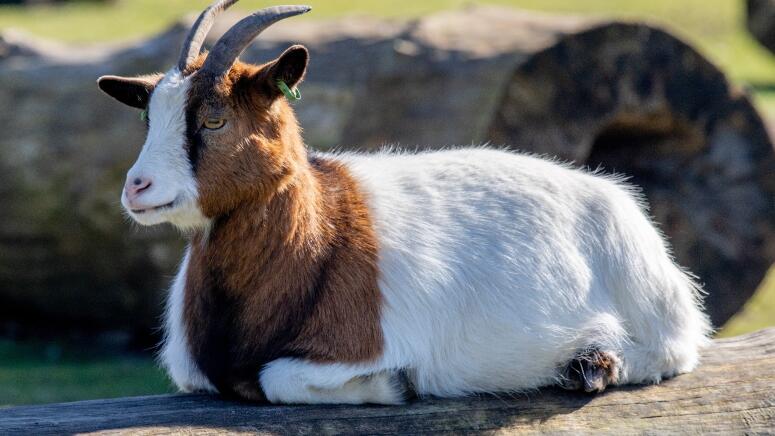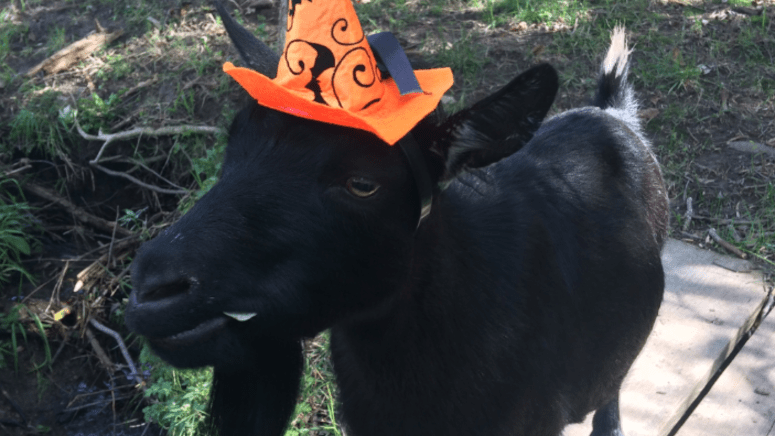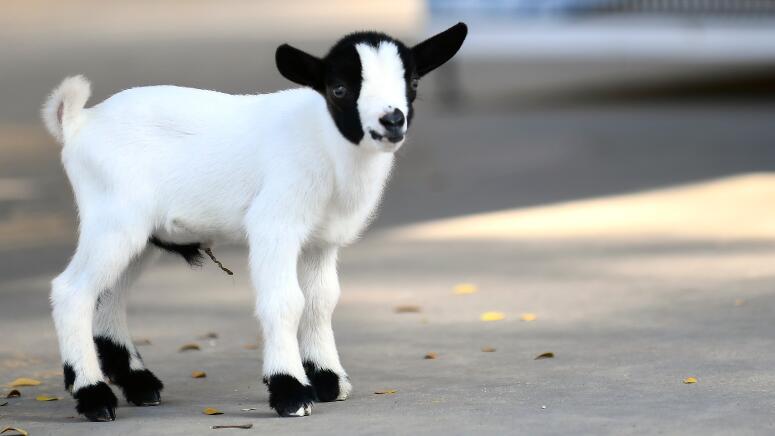Posted by Jennifer Sartell, Professional Homesteader & Blogger, Mon, May 4, 2015; updated Tue, Mar 19, 2024
Every time one of our goats gives birth for the first time, it serves as a transition for how we see her. Our little girls become big girls and I tend to get emotional about the whole thing. Seeing her care for her babies changes and deepens the relationship, showing an instinctual side that we’ve never witnessed. It’s very beautiful.
One of the most amazing parts is watching her know exactly what to do. She reads no books, attends no birthing classes, and yet understands her body and what is right for her kids.
It’s so easy to get stressed out when your goat is expecting. We’ve created this in-depth guide to goat pregnancy, goat delivery and goat birth to try to help ease your mind. Read on for some key tips!
What is the term for a goat giving birth?
Before we dive into goat pregnancy tips and more, let’s get a couple of definitions down first.
- Kidding: The process of a goat giving birth. It is the term used to describe the labor and delivery phase in goats.
- Doe: A female goat. In the context of pregnancy and kidding, the doe is the one who carries and delivers the kids.
- Buck: A male goat. The buck is important for breeding purposes and is not directly involved in the pregnancy or kidding process, other than fertilization.
- Freshening: This term refers to the process of a doe giving birth and beginning to produce milk. Freshening is significant for dairy goat farmers who rely on milk production.
- Gestation Period: The duration of pregnancy in a goat. The average gestation period for goats is 150 days, but it can vary depending on the breed and other factors.
- Parturition: Another term for the act of giving birth, applicable to all mammals, including goats.
- Kid(s): The term used for young goats, especially newborns. In the context of kidding, it refers to the offspring resulting from the pregnancy.
- Colostrum: The first form of milk produced by the doe immediately following kidding. Colostrum is rich in antibodies and nutrients, vital for the newborn kids' immunity and health.
- Dystocia: Refers to difficult labor or childbirth. For example, the kid being positioned incorrectly or being too large to pass through the birth canal.
- Weaning: The process of transitioning young goats from milk to solid food. While not directly related to pregnancy or kidding, it's an important next step in the care and management of the offspring.

What to Expect When Your Goat is Expecting
Some goats hide their pregnancies well. Some of our girls develop huge bulging sides, leaving no doubt that she has babies growing within. Some of our other goats carry much more discreetly. Because of this, it can be difficult to tell if your goat is indeed pregnant.
Signs your goat is pregnant
One of the first signs is bagging udders. If you have a seasoned doe, she will sometimes make udders within a month of giving birth. First-time does tend to bag up later, sometimes only a week to a few days before giving birth.
A first-timer’s udders might be smaller and held tightly to her body. Her teats might stay small for a while as well.
As the babies grow inside her, you will be able to feel kicking. Place a flat hand on her lower right side, in front of her udders and on the inside of her leg. You will often feel the bump of a nose, or the point of a soft hoof.
Because we see our goats every day, subtle changes in her growing body can be hard to keep track of. A great tool is to take a few photos of your doe when she isn’t pregnant. You can compare these images to view how your goat is progressing. Sometimes the changes are quite noticeable.
How long are goats pregnant?
We introduce our bucks on Halloween. Why Halloween, you might wonder? Well, it's an easy date to remember, and it fits well into the agricultural calendar for goat breeding.
A goat's pregnancy, also known as the gestation period, typically lasts between 140 to 150 days. That's about 5 months! Therefore we mark our calendars and start getting ready for new arrivals around early March.
During this waiting period, we keep a close eye on our does for any signs that kidding is near. These signs can include changes in behavior, physical changes, and even the doe starting to 'nest' or get her birthing area ready (more on that below).
It's an exciting time on the farm, and every farmer has their own set of preparations and observations they make to ensure everything goes smoothly for both the does and the soon-to-arrive kids.

Goat Labor Signs
What are the stages of labor in goats?
As a pro farmer or homesteader, understanding the stages of labor in goats is crucial for ensuring a safe and healthy kidding process. Labor in goats unfolds in three main stages:
- Preparation: The doe becomes restless, may separate from the herd, and starts to 'nest'. You might notice her tail raising frequently and her sides hollowing out as she gets ready.
- Delivery: This is when the real action happens! The doe will lie down and start pushing. First, you'll see the water bag, followed by the baby goat, or 'kid', making its entrance into the world.
- Afterbirth: After all kids are born, the doe will deliver the placenta. This usually happens within a few hours post-delivery. It's important to ensure the placenta is fully expelled to prevent health issues.
By knowing these stages, you can provide the right support at the right time, ensuring a smooth kidding experience.
First signs of active labor in goats:
All goats are different. Each doe may exhibit different signs that she is going into labor. Some goats are very subtle, while others are more obvious. As you witness more births, you will begin to notice changes and similarities among your girls.
Here are some common pre-labor behaviors we see in our herd.
- Arching and stretching of the back
- Lengthened or awkward tail position
- Pawing at the ground
- Gathering bedding, moving things around with her nose or “nesting”
- Waddling when she walks, with a spread to the hind legs
- Difficulty getting comfortable while lying down
- Udder formation
- Teat lengthening and growing in circumference
Here are some personality changes we often observe:
- Oftentimes our does will develop this “glazed over” look to them. We call it the pregnancy trance. It’s a subtle thing, but if you know your goats well you might pick up on it. Our goats are usually perky, rambunctious and alert, but when they’re getting close to delivery day they act as if they’re daydreaming
- Our goats also love to greet us by jumping up on their fences/gates/paddocks. I notice that our heavily pregnant girls are reluctant to get up on things
- Some does that are friendly won’t want to be touched, while others might want extra affection

How long does it take a goat to give birth? (Goat Labor Timeline)
When it's time for a goat to give birth, it can vary quite a bit. Some does are quick and might have their kids in just a few hours, while others take a bit longer, especially if it's their first time or they have multiple kids.
On average, from the first signs of labor to when the last kid arrives, it can take anywhere from 1 to 12 hours. We farmers keep a close eye on them to make sure everything goes smoothly and step in if they need a helping hand.
Getting Closer
Check for these signs as the labor develops. This is when you want to check your doe often and have supplies close at hand. (Visit my Goat Birthing Kit post for more information.)
- A wave effect across the side of her abdomen
- Teeth grinding
- Lying down and standing up (signs of discomfort)
- She might breathe heavily, lower her head and close her eyes
Last Stages of Goat Pregnancy
- Pin bone softening
- Leaking from the vulva, or loosing the plug. The discharge often starts out clear, then becomes thicker and more opaque as labor progresses
- Vulva swelling
- Vulva opening and lengthening
- Bleating, moaning, grunting and heavy panting
- Some goats will give birth lying down, while others prefer to stand. Some will even walk around and eat as the kid is coming out
Delivery
When birth starts, the goat might rock a bit and push. A bubble filled with liquid will appear from her vagina. This is the amniotic membrane. The bubble will come out a little at a time. It might contract slightly after the push is over.
If everything is as it should be, you will see two little hooves inside the bubble followed by a nose. If the doe is having a hard time, after the head is delivered I often break the bubble if it hasn’t broken already. This will ease her labor.
Clear the newborn kid’s nasal passages immediately. It will sometimes shake its head. The doe should continue to push and deliver the kid rather quickly. The last of the kid will be delivered swiftly, sliding out in one swooshing motion.
Make sure that, if you are assisting the doe, you bring the kid up to her face immediately after giving birth. Again, check to make sure the kid is breathing and allow the doe to begin cleaning the kid.
Birth Positions
Goats can successfully deliver kids in several different positions without assistance. However, two of the most dangerous are when the head is back, or when she tries to deliver two kids at the same time.
If the head doesn’t appear shortly after the hooves and the doe seems to be in distress, then it’s time to check the kid’s position.
Wear clean surgical gloves and apply a personal lubricant to your fingers. Be very gentle, and only insert as much of your hand as needed. I tend to use two fingers. If the head is back, you will feel the neck straining backward. Reach in as far as necessary and try to pull the head around. You might have to push the kid back slightly to make room for the head to turn. If all is well, the kid should be born quickly after.
One of our Alpine does attempted to deliver two of her triplets at the same time. Both bubbles appeared along with two sets of hooves. I broke the bubble of the kid that had progressed the most and gently stopped the other one from progressing. With each push of the doe, I pulled the pair of hooves and stopped the other kid from coming out. Eventually, with little involvement from me, the kids rearranged themselves in the birth canal and the first kid was born, followed shortly by the second.
What to do when a goat gives birth?
Aftercare
Doe
Give the doe time to rest. Often she will have another kid to deliver, so she needs this precious time to take care of her first kid and let her body gain some strength.
She will appreciate a bucket of warm molasses water. The sugar will give her energy, the water will rehydrate her and the iron will replenish her body. She might also take grain if offered. But don’t distract her with too many food options—you want her focus to be on her kid.
When all her kids have been delivered, we offer water with electrolytes. Our does drink an enormous amount of water after birth. To support hydration and optimal fluid balance, try Manna Pro® Goat Electrolyte. This product is formulated to keep goats hydrated during times of stress.
Within a half hour after giving birth, she will deliver the placenta. I usually try to catch the placenta on a tarp or feed bag so she can easily eat it without it getting mixed into the bedding. While this might seem strange, it is a natural thing, healthy and instinctual.
Kids
Make sure the kids are dried thoroughly, especially if the weather is chilly and mom is concentrating on delivering additional kids.
Tie the umbilical cord about 3/4 of an inch away from the belly with floss. Snip the extra so it doesn’t get stepped on and tugged off. Dip the tied cord in iodine to prevent bacteria from entering the cord. This dipping can be repeated twice a day for the first two days.
Within the first hour after birth, the kid should be attempting to stand and nurse. This is an adorable balancing act and a delicate dance between mother and kid. A good mother will open her leg and sort of squat to encourage the kid to latch. She will often lick their rear end and mumble soft, throaty “maas” to her kid. It is beautiful to watch them communicate.
In this first hour the kid will ingest their first meal. The doe will have filled her udders with nutrient-dense colostrum, which will provide a healthy beginning to her kid’s future.
How soon can a goat get pregnant after giving birth?
I've seen my fair share of kiddings and one question that often comes up is about how soon a doe can get pregnant again after giving birth. Well, let me shed some light on this.
Goats are quite resilient and can technically become pregnant again pretty quickly after giving birth. However, as responsible farmers, we give our does a well-deserved break to recover fully and take care of their newborn kids. This rest period is crucial for their health and the health of their future kids.
Typically, we wait until the newborn kids are weaned before considering breeding the doe again. Weaning happens around 2 to 3 months after birth, but we usually give the doe a few extra months to regain her strength. So, in practice, a doe might be ready for breeding again about 4 to 5 months after giving birth, ensuring she's in tip-top condition to embark on the journey of motherhood once more.
Remember, every goat is unique, and as pro farmers, we pay close attention to each doe's health and well-being before deciding on the right time for rebreeding.
Author Profile: Jennifer Sartell
Jennifer Sartell is the primary caretaker of all animals on her and her husband’s farm in Fenton, MI. With a passion for living a simple life, Jennifer enjoys creating art, taking in nature, raising animals and has developed a deep appreciation for homesteading. Jennifer and her husband, Zach, currently raise goats and poultry.
Her vast amount of experience on the farm includes, but is not limited to: milking, shearing, hoof trimming, vaccine administration, assisting in animal births, dehorning, egg collecting, chick and turkey hatching, feeding, watering, etc. She can also cook a mean farm-to-table meal and when the day is done has documented and photographed their day on the farm.
More Blogs by Jennifer Sartell
- https://www.mannapro.com/homestead/caring-for-pregnant-does-part-2
- https://www.mannapro.com/homestead/caring-for-pregnant-does-part-1
- https://www.mannapro.com/homestead/preparing-caring-for-goats-in-winter
- https://www.mannapro.com/homestead/dairygoatbreeds
- https://www.mannapro.com/homestead/preparing-the-kidding-stall-part-2
- https://www.mannapro.com/homestead/a-guide-to-buying-a-new-goat
- https://www.mannapro.com/homestead/raising-kids-dehorning-wethering
- https://www.mannapro.com/homestead/milking-a-goat
- https://www.mannapro.com/homestead/raising-fiber-goats-101
- https://www.mannapro.com/homestead/hoof-care-for-goats
- https://www.mannapro.com/homestead/putting-together-a-goat-birthing-kit
- https://www.mannapro.com/homestead/preparing-the-kidding-stall-part-1
- https://www.mannapro.com/homestead/breaking-down-the-goat-diet
- https://www.mannapro.com/homestead/birthing-goat-kids
- https://www.mannapro.com/homestead/dealing-with-goat-scours
- https://www.mannapro.com/homestead/feeding-baking-soda-to-your-goats
- https://www.mannapro.com/homestead/pros-cons-and-facts-about-raising-turkeys
- https://www.mannapro.com/homestead/best-breeds-for-raising-chickens-with-children
- https://www.mannapro.com/homestead/a-guide-to-small-goat-breeds

Feature Products

